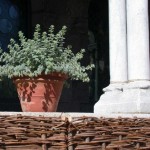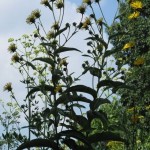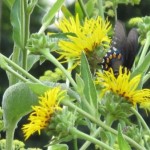Archive for the ‘Fragrant Plants’ Category
Thursday, October 4, 2012
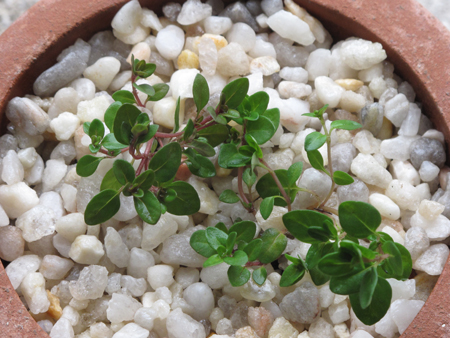
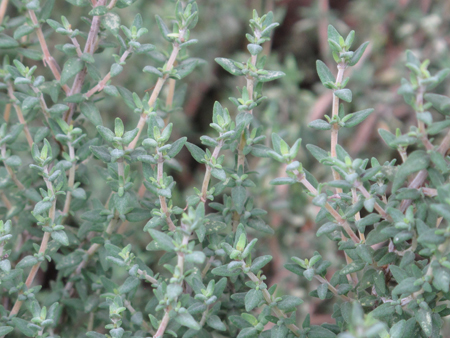
From right to left: A small start of wild or creeping thyme, a native of Northern Europe, in a terra rossa pot; detail of a planting of common or garden thyme, indigenous to the Western Mediterranean, growing in a sunny bed under the parapet wall in Bonnefont cloister. Although these two plants are easily distinguished in the garden, it can be difficult to know which of several species of thyme is under discussion in ancient and medieval sources.
There are hundreds of?? species in the genus Thymus, and a large and confusing array of hybrids and cultivated forms.??Ancient and medieval sources agree on the heating and drying properties of thyme, which is still greatly valued for its antibacterial and antifungal properties, but the species known in the European Middle Ages were not those of the ancients. The attempt to equate the plants discussed by Dioscorides in the De Materia Medica with more familiar species would occupy botanists well into the Renaissance.
Read more »
Tags: Dioscorides, Hildegard of Bingen, Pliny, thyme
Posted in Botany for Gardeners, Food and Beverage Plants, Fragrant Plants, Gardening at The Cloisters, Medicinal Plants | Comments (1)
Friday, September 21, 2012
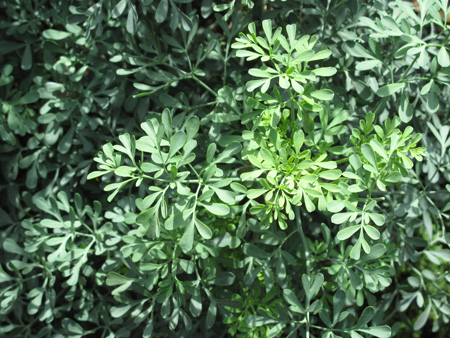
The blue-green fronds of rue were admired for their beauty in the Middle Ages, and the intensely aromatic leaves were prized as a condiment, a medicament, and an amulet.?? Photograph by Carly Still
Here is a shadowed grove which takes its color
From the miniature forest of glaucous rue.
Through its small leaves and short umbels which rise
Like clusters of spears it sends the wind???s breath
And the sun’s rays down to its roots below.
Touch it but gently and it yields a heavy
Fragrance. Many a healing power it has ???
Especially, they say, to combat
Hidden toxin and to expel from the bowels
The invading forces of noxious poison.
???Hortulus, Walahfrid Strabo, translated by Raef Payne
Read more »
Tags: Anethum graveolens, Apicius, Apium graveolens, bitter, Capitulare de Villis, Dioscorides, Hildegard of Bingen, Hortulus, Mithridates VI, mithridatum, phytodermatitis, Pliny, rue, Ruta graveolens, St. Gall, Tacuinum Sanitatis, Walahfrid Strabo
Posted in Food and Beverage Plants, Fragrant Plants, Gardening at The Cloisters, Magical Plants, Medicinal Plants | Comments (0)
Friday, May 25, 2012
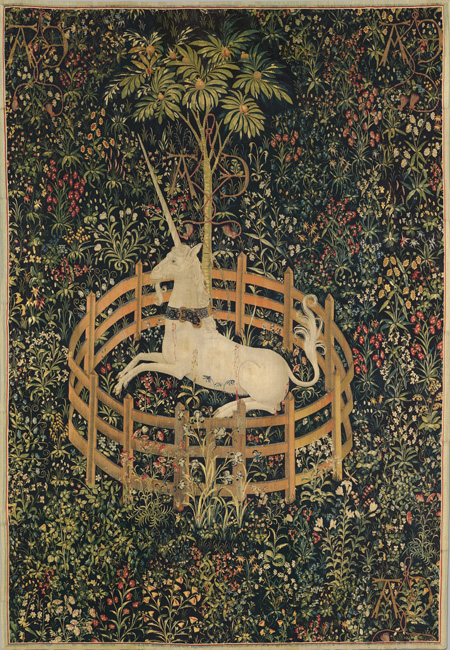
The Unicorn in Captivity, 1495???1505. The Metropolitan Museum of Art, New York, Gift of John D. Rockefeller Jr., 1937 (37.80.6). The profusion of flowering plants that springs from the millefleurs meadow on which the unicorn rests includes both garden plants and wildflowers. An iris and a clove pink are prominently placed outside the unicorn’s enclosure; both were intensively cultivated in the Middle Ages, but the purple orchis silhouetted against the unicorn’s body depends on a special relationship with microorganisms in its native soil and would not have grown in gardens.
Roses, lilies, iris, violet, fennel, sage, rosemary, and many other aromatic herbs and flowers were prized for their beauty and fragrance, as well as their culinary and medicinal value, and were as much at home in the medieval pleasure garden as in the kitchen or physic garden. These plants were carefully cultivated, but many useful plants of the Middle Ages were found outside the garden walls, or admitted on sufferance.
Read more »
Tags: colewort, Fennel, gourd, herb, Hortulus, iris, kale, lamb's quarters, lettuce, lily, melon, nettle, poppy, pulse, purslane, rose, rosemary, sage, violet, Walahfrid Strabo
Posted in Food and Beverage Plants, Fragrant Plants, Medicinal Plants, Plants in Medieval Art, Useful Plants | Comments (1)
Thursday, April 19, 2012
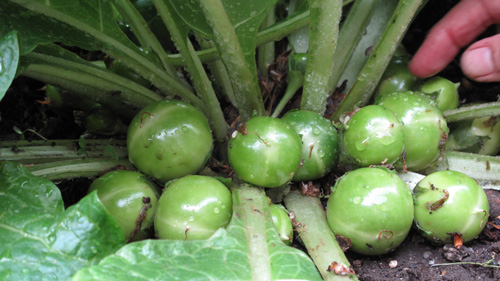
The mandrake above, which flowered in March, now bears a bumper crop of no less than twenty fruits, the largest number we’ve ever seen on a single plant here in Bonnefont garden. The fruits do not always ripen fully for us.?? Photograph by Carly Still
The mandrakes give a smell, and at our gates are all manner of pleasant fruits, new and old, which I have laid up for thee, O my beloved.
???Song of Solomon, 7:13
Read more »
Tags: Mandragora, Mandragora officinarum, mandrake, nightshade, Tacuinum Sanitatis, tomato
Posted in Fragrant Plants, Gardening at The Cloisters, Magical Plants | Comments (2)
Friday, October 28, 2011
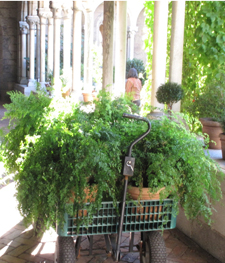
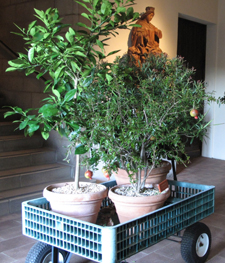
Potted plants too tender to spend the winter in Bonnefont garden are trucked inside and brought up to Cuxa cloister, which is??glazed in mid-October. Mediterranean plants such as bitter orange, myrtle, and bay laurel spend the cold season in the sunny arcades and??are brought back out to the herb garden when the glass comes down in mid-April. Left:??A wagonload of maidenhair fern in the arcade of Bonnefont garden. Right:??oranges and pomegranates en route to Cuxa cloister.?? Photographs by Carly Still
While the medieval plant collection at The Cloisters includes a good number of northern European species, a great many of the plants grown in the Bonnefont Cloister herb garden are Mediterranean in origin. Not all of these southern European plants are hardy for us here in New York City. The garden is a sheltered U.S.D.A. Hardiness Zone 7, and the fig tree (Ficus carica), poet’s jasmine (Jasminum officinale), and lavender (Lavandula angustifolia) do just fine outdoors, but more tender species like bitter orange (Citrus aurantium), rosemary (Rosmarinus officinalis), bay laurel (Laurus nobilis), and dittany of Crete (Origanum dictamnus) must be brought inside and protected from the cold. Read more »
Tags: Albertus Magnus, bay, Citrus aurantium, cucumber, cucurbit, dittany, fern, ficus carica, fig, jasmine, Jasminum officinale, laurel, Laurus nobilis, Lavandula angustifolia, Lavender, maidenhair, myrtle, orange, Origanum dictamnus, rosemary, Rosmarinus officinalis, santolina, winter
Posted in Food and Beverage Plants, Fragrant Plants, Gardening at The Cloisters, Introduction, Magical Plants, Medicinal Plants, Medieval Agriculture, Plants in Medieval Art | Comments (2)
Friday, July 8, 2011
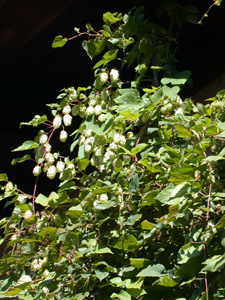
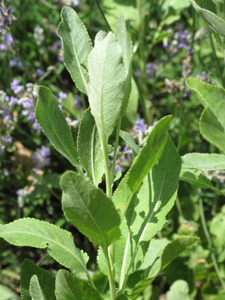
Hops (Humulus lupulus), considered today to be crucial to beer brewing, were not commonly used until the fifteenth century. Before that time, brewers added different herbs, such as??alecost??(Tanacetum balsamita), to their beer to improve its flavor. Several of these medieval brewing herbs can be found in Bonnefont garden.
Ale is made of malte and water; and they the which do put any other thynge to ale then is rehersed, except yest, barme, or godesgood, doth sofystical theyr ale.
???Andrew Borde, The fyrst boke of the introduction of knowledge, 1452
Beer was a staple drink for medieval Europeans, as it provided much-needed calories to the often undernourished population and was cleaner and safer to drink than water. Then, as now,??beer was made by brewing malted barley in boiling water to make sugars more available for yeasts to consume (see an image of Jorg Prewmaister tending his brew in a page from a fifteenth-century German manuscript, Amb. 317.2). This sugary, malty potion, known as “wort,” eventually becomes beer after the yeasts eat the sugars, releasing carbon dioxide and alcohol as byproducts of fermentation. On its own, wort is fairly flat in flavor, so brewers add additional ingredients, such as hops and spices, to enliven a beer’s taste.
Read more »
Tags: Achillea millefolium, Add new tag, ale, alecost, barley, beer, brew, bryan_stevenson, costmary, Glechoma hederacea, ground ivy, gruit, hops, humulus lupulus, Ledum palustre, malt, Myrica gale, Reinheitsgebot, stinging nettle, sweet gale, Tanacetum balsamita, Urtica dioica, wild rosemary, wort, yarrow
Posted in Botany for Gardeners, Food and Beverage Plants, Fragrant Plants, Medicinal Plants | Comments (3)
Friday, June 17, 2011
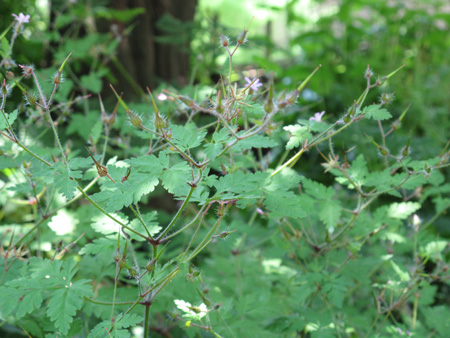
Herb Robert (Geranium robertianum), called ruprechtskraut in German, is sometimes said to derive its name from the seventh-century Saint Rupert or Robert of Salzburg, but the plant is also associated with the German hobgoblin Knecht Ruprecht and his English counterpart, Robin Goodfellow.
Either I mistake your shape and making quite,
Or else you are that shrewd and knavish sprite
Call’d Robin Goodfellow: are not you he
That frights the maidens of the villagery;
Skim milk, and sometimes labour in the quern
And bootless make the breathless housewife churn;
And sometime make the drink to bear no barm;
Mislead night-wanderers, laughing at their harm?
Those that Hobgoblin call you and sweet Puck,
You do their work, and they shall have good luck:
Are not you he?
A Midsummer Night’s Dream, Act II, Scene 1
Read more »
Tags: cranesbill, Dioscorides, Geoffrey Grigson, Geranium robertianum, herb robert, Herba Sancti Ruperti, Hildegard of Bingen, John Gerard, Ruprecht, Tanacetum
Posted in Fragrant Plants, Medicinal Plants | Comments (2)
Friday, April 1, 2011
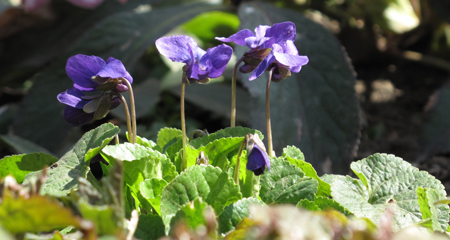
The sweet-smelling, short-stemmed garden violet (Viola odorata) blooms from late March into April. Prized in medieval pleasure gardens for its color and scent, this violet was also at home in kitchen and physic gardens. Photograph by Corey Eilhardt
Native to woodland margins and damp and shady places throughout Europe, the early blooming Viola odorata was prized for its fragrance as well as its rich purple color. The sweet violet is included in Albertus Magnus’ list of desirable flowers for the pleasure garden, along with the lily and the rose. These three flowers are often linked symbolically as well as horticulturally in medieval sources, as flowers of Paradise and as emblems of the Virgin???the low-growing but beautiful and sweet-scented violet was equated with Mary’s humility. Read more »
Tags: Albertus Magnus, Gode cookery, Herbarius Latinus, Hildegard von Bingen, Hortus Sanitatis, Physica, Tacuinum Sanitatis, Viola odorata, violet
Posted in Fragrant Plants, Gardening at The Cloisters | Comments (1)
Friday, August 6, 2010
Above: The left and center image show the true or “right dittany” of Crete (Origanum dictamnus), a tender Mediterranean species grown in pots in Bonnefont garden. This pretty relative of the culinary oreganos is endemic to the island, and is found growing wild only in the mountains there. The small, purplish-pink flowers are borne on long-lasting bracts in late summer and fall. The image on the right shows Dictamnus albus, known as white dittany or fraxinella, which is a botanically unrelated species. Medieval herbalists seem to have transferred both the name and the??marvelous properties that the ancients ascribed to true dittany to this herb.
Origanum dictamnus, with its round, woolly gray leaves,??rosy??bracts and delicate purplish-pink flowers, is the prettiest of the tender medieval species grown in pots in Bonnefont garden, and the most difficult for us to grow. One of a number of species endemic to the mountains of Crete, the wild plant is only found growing in the crevices of limestone gorges and ravines (see image). Known as diktamnon in Greek, it is said to be named after Mount Dikti. Read more »
Tags: Aeneas, antidote, Aristotle, artemidon, Artemis, Bonnefont Garden, Cos, Crete, diktamnon, Dioscorides, Hellmut Baumann, Hippocrates, Mount Ida, Origanum dictamnus, snake, snakebite, Theophrastus, venom, Venus, Virgil, William Turner
Posted in Fragrant Plants, Gardening at The Cloisters, Medicinal Plants | Comments (1)
Tuesday, July 13, 2010
Above, left: Elecampane growing in a bed in Bonnefont garden devoted to??medieval vegetables. The bright yellow flowers of this striking plant are borne high on tall stems that can reach an imposing height of six feet. Right: Detail of the fringed flowers, typical of the daisy family. Photographs by Corey Eilhardt.
The tall and showy elecampane (Inula helenium) is a striking presence along roadsides, in pastures, and on waste grounds both in Europe and in the United States, where it is considered an invasive weed by the U.S.D.A., especially in the moist and shady situations it prefers. It is nevertheless still widely planted in ornamental gardens for its imposing height, bold foliage, and bright yellow flowers, which come into bloom at midsummer. Read more »
Tags: aromatic, daisy, elecampane, inula helenium, inulin, invasive, John Gerard, ornamental
Posted in Food and Beverage Plants, Fragrant Plants, Magical Plants, Medicinal Plants | Comments (1)












